Relationship between Mineral and Organic Matter in Shales: The Case of Shahejie Formation, Dongying Sag, China
Abstract
:1. Introduction
2. Geological Setting
3. Materials and Methods
3.1. Thin-Section Observations
3.2. SEM Observation
3.3. X-ray Diffraction (XRD)
3.4. Pyrolysis
4. Results
4.1. Lithofacies
4.1.1. Shales
4.1.2. Mudstones
4.1.3. Anhydrite-Rich Mudstones
4.2. Mineral Compositions
4.3. Pyrolysis Characteristics
4.3.1. TOC
4.3.2. Hydrogen Index (HI), Oxygen Index (OI) and Types of Kerogen
5. Discussion
5.1. Sedimentary Characteristics of Minerals and OM
5.2. Organic Matter and Mineral Associations
5.2.1. Relationship between Clay Minerals and OM
5.2.2. Relationship between Carbonate Minerals and OM
5.2.3. Relationship between Detrital Minerals and OM
5.3. Sedimentary Characteristics of Each Lithofacies and Each Member
6. Conclusions
Author Contributions
Funding
Acknowledgments
Conflicts of Interest
References
- Kelts, K. Environments of deposition of lacustrine petroleum source rocks: An introduction. Geol. Soc. Lond. Spec. Publ. 1988, 40, 3–26. [Google Scholar] [CrossRef]
- Chen, S.; Zhang, S.; Wang, Y.; Tan, M. Lithofacies types and reservoirs of Paleogene fine-grained sedimentary rocks in Dongying Sag, Bohai Bay Basin. Pet. Explor. Dev. 2016, 43, 218–229. [Google Scholar] [CrossRef]
- Loucks, R.G.; Ruppel, S.C. Mississippian Barnett Shale: Lithofacies and depositional setting of a deep-water shale-gas succession in the Fort Worth Basin, Texas. AAPG Bull. 2007, 91, 579–601. [Google Scholar] [CrossRef]
- Hickey, J.J.; Henk, B. Lithofacies summary of the Mississippian Barnett Shale, Mitchell 2 TP Sims well, Wise County, Texas. AAPG Bull. 2007, 91, 437–443. [Google Scholar] [CrossRef]
- Liang, C.; Jiang, Z.; Yang, Y.; WEI, X. Shale lithofacies and reservoir space of the Wufeng–Longmaxi Formation, Sichuan Basin, China. Pet. Explor. Dev. 2012, 39, 736–743. [Google Scholar] [CrossRef]
- Xie, X.; Li, M.; Littke, R.; Huang, Z.; Ma, X.; Jiang, Q.; Snowdon, L.R. Petrographic and geochemical characterization of microfacies in a lacustrine shale oil system in the Dongying Sag, Jiyang Depression, Bohai Bay Basin, eastern China. Int. J. Coal Geol. 2016, 165, 49–63. [Google Scholar] [CrossRef]
- Liu, C.; Wang, P. The role of algal blooms in the formation of lacustrine petroleum source rocks—Evidence from Jiyang depression, Bohai Gulf Rift Basin, eastern China. Palaeogeogr. Palaeoclimatol. Palaeoecol. 2013, 388, 15–22. [Google Scholar] [CrossRef]
- Schieber, J. Benthic microbial mats as an oil shale component. In Atlas of Microbial Mat Features Preserved within the Siliciclastic Rock Record, 1st ed.; Schieber, J., Bose, P.K., Eriksson, P., Banerjee, S., Sarkar, S., Altermann, W., Catuneanu, O., Eds.; Elsevier: Amsterdam, The Netherlands, 2007; Volume 2, pp. 225–232. [Google Scholar]
- Bennett, R.H.; O’Brien, N.R.; Hulbert, M.H. Determinants of clay and shale microfabric signatures: Processes and mechanisms. In Microstructure of Fine-Grained Sediments, 1st ed.; Chiou, W., Faas, R., Kasprowicz, J., Li, H., Lomenick, T., O’Brien, N., Pamukcu, S., Smart, P., Weaver, C., Yamamoto, T., Eds.; Springer: New York, NY, USA, 1991; pp. 5–32. [Google Scholar]
- Wu, Y.; Ji, L.; He, C.; Zhang, Z.; Zhang, M.; Sun, L.; Su, L.; Xia, Y. The effects of pressure and hydrocarbon expulsion on hydrocarbon generation during hydrous pyrolysis of type-I kerogen in source rock. J. Nat. Gas Sci. Eng. 2016, 34, 1215–1224. [Google Scholar] [CrossRef]
- Zhu, X.; Cai, J.; Wang, X.; Zhang, J.; Xu, J. Effects of organic components on the relationships between specific surface areas and organic matter in mudrocks. Int. J. Coal Geol. 2014, 133, 24–34. [Google Scholar] [CrossRef]
- Zhang, J.; Cai, J.; Wang, X.; Xu, J. Palynofacies of lacustrine source rocks in Dongying Depression and its significance. J. Cent. South Univ. 2013, 44, 3446–3452. [Google Scholar]
- Zeng, X.; Cai, J.; Dong, Z.; Wang, X.; Hao, Y. Sedimentary characteristics and hydrocarbon generation potential of mudstone and shale: A case study of Middle Submember of Member 3 and Upper Submember of Member 4 in Shahejie Formation in Dongying sag. Acta Pet. Sin. 2017, 38, 31–43. [Google Scholar]
- SY/T 5163-1995. Analysis of Relative Content of Clay Minerals in Sedimentary Rocks by X-ray Diffraction; Petroleum Industry Press: Beijing, China, 1995. [Google Scholar]
- He, J.; Ding, W.; Jiang, Z.; Kai, J.; Li, A.; Sun, Y. Mineralogical and chemical distribution of the Es3L oil shale in the Jiyang Depression, Bohai Bay Basin (E China): Implications for paleoenvironmental reconstruction and organic matter accumulation. Mar. Pet. Geol. 2017, 81, 196–219. [Google Scholar] [CrossRef]
- SY/T 6210-1996. Quantitative Analysis of Total Contents of Clay Minerals and Common Non-clay Minerals in Sedimentary Rocks by X-ray Diffraction; Petroleum Industry Press: Beijing, China, 1996. [Google Scholar]
- Langford, F.F. Interpreting Rock-Eval pyrolysis data using graphs of pyrolizable hydrocarbons vs. Total Organic Carbon. AAPG Bull. 1990, 74, 799–804. [Google Scholar]
- Reynolds, S.; Gorsline, D.S. Silt Microfabric of Detrital, Deep Sea Mud(stone)s (California Continental Borderland) as Shown by Backscattered Electron Microscopy. In Microstructure of Fine-Grained Sediments: From Mud to Shale, 1st ed.; Bennett, R.H., Bryant, W.R., Hulbert, M.H., Chiou, W.A., Faas, R.W., Kasprowicz, J., Li, H., Lomenick, T., O’Brien, N.R., Pamukcu, S., et al., Eds.; Springer: New York, NY, USA, 1991; pp. 203–211. [Google Scholar]
- Yang, T.; Cao, Y.; Wang, Y.; Zhang, S. Types, sedimentary characteristics and genetic mechanisms of deep-water gravity flows: A case study of the middle submember in Member 3 of Shahejie Formation in Jiyang depression. Acta Pet. Sin. 2015, 36, 1048–1059. [Google Scholar]
- Wang, G. Laminae combination and genetic classification of Eogene shale in Jiyang Depression. J. Jilin Univ. 2012, 42, 666–680. [Google Scholar]
- Liu, C.; Wang, P.; Xu, J. Algal blooms: the primary mechanism in the formation of lacustrine petroleum source rocks. Geol. Rev. 2001, 47, 207–210. [Google Scholar]
- Liu, C.; Shu, X.; Liu, Z. Micro-characteristics of Paleogene Lacustrine Petroleum Source Rocks in Jiyang Depression. Acta Sedimentol. Sin. 2001, 19, 293–298. [Google Scholar]
- Pamukcu, S.; Tuncan, M. Influence of Some Physicochemical Activities on Mechanical Behavior of Clays. In Microstructure of Fine-Grained Sediments, 1st ed.; Chiou, W., Faas, R., Kasprowicz, J., Li, H., Lomenick, T., O’Brien, N., Pamukcu, S., Smart, P., Weaver, C., Yamamoto, T., Eds.; Springer: New York, NY, USA, 1991; pp. 241–253. [Google Scholar]
- Kase, Y.; Sato, M.; Nishida, N.; Ito, M.; Mukti, M.M.R.; Ikehara, K.; Takizawa, S. The use of microstructures for discriminating turbiditic and hemipelagic muds and mudstones. Sedimentology 2016, 63, 2066–2086. [Google Scholar] [CrossRef]
- Flugel, E.; Munnecke, A. Microfacies of Carbonate Rocks: Analysis, Interpretation and Application; Springer: Berlin, Germany, 2010; pp. 74–99. [Google Scholar]
- Tyson, R.V. Sedimentary Organic Matter: Organic Facies and Palynofacies; Chapman and Hall: New York, NY, USA, 1995; pp. 22–24. [Google Scholar]
- Tissot, B.P.; Welte, D.H. Petroleum Formation and Occurrence; Springer-Verlag: Berlin, Germany, 1984; pp. 160–214. [Google Scholar]
- Bergaya, F.; Theng, B.K.; Lagaly, G. Handbook of Clay Science; Elsevier: Amsterdam, The Netherlands, 2011; pp. 10–25. [Google Scholar]
- Schieber, J.; Southard, J.; Thaisen, K. Accretion of mudstone beds from migrating floccule ripples. Science 2007, 318, 1760–1763. [Google Scholar] [CrossRef] [PubMed]
- Turner, J.T. Zooplankton fecal pellets, marine snow, phytodetritus and the ocean’s biological pump. Prog. Oceanogr. 2015, 130, 205–248. [Google Scholar] [CrossRef]
- Zhang, J.; Jiang, Z.; Jiang, X.; Wang, S.; Liang, C.; Wu, M. Oil generation induces sparry calcite formation in lacustrine mudrock, Eocene of east China. Mar. Pet. Geol. 2016, 71, 344–359. [Google Scholar] [CrossRef]
- Schieber, J.; Bose, P.K.; Eriksson, P.; Banerjee, S.; Sarkar, S.; Altermann, W.; Catuneanu, O. Atlas of Microbial Mat Features Preserved within the Siliciclastic Rock Record; Elsevier: Amsterdam, The Netherlands, 2007; pp. 44–46. [Google Scholar]
- Fan, D.; Shang, S.; Cai, G.; Tu, J. Distinction and grain-size characteristics of intertidal heterolithic deposits in the middle Qiantang Estuary (East China Sea). Geo-Mar. Lett. 2015, 35, 161–174. [Google Scholar] [CrossRef]
- McCave, I.N.; Manighetti, B.; Robinson, S.G. Sortable silt and fine sediment size/composition slicing: Parameters for palaeocurrent speed and palaeoceanography. Paleoceanography 1995, 10, 593–610. [Google Scholar] [CrossRef]
- Homewood, P. Fine-Grained Turbidite Systems. Basin Res. 2001, 13, 377. [Google Scholar] [CrossRef]
- Li, H.; Bennett, R.H. The significance of sediment-flow dynamics on clay microstructure development: Riverine and continental shelf environments. In Microstructure of Fine-Grained Sediments; Chiou, W., Faas, R., Kasprowicz, J., Li, H., Lomenick, T., O’Brien, N., Pamukcu, S., Smart, P., Weaver, C., Yamamoto, T., Eds.; Springer: New York, NY, USA, 1991; pp. 193–202. [Google Scholar]
- Liang, C.; Cao, Y.; Liu, K.; Jiang, Z.; Wu, J.; Hao, F. Diagenetic variation at the lamina scale in lacustrine organic-rich shales: Implications for hydrocarbon migration and accumulation. Geochim. Cosmochim. Acta 2018, 229, 112–128. [Google Scholar] [CrossRef]

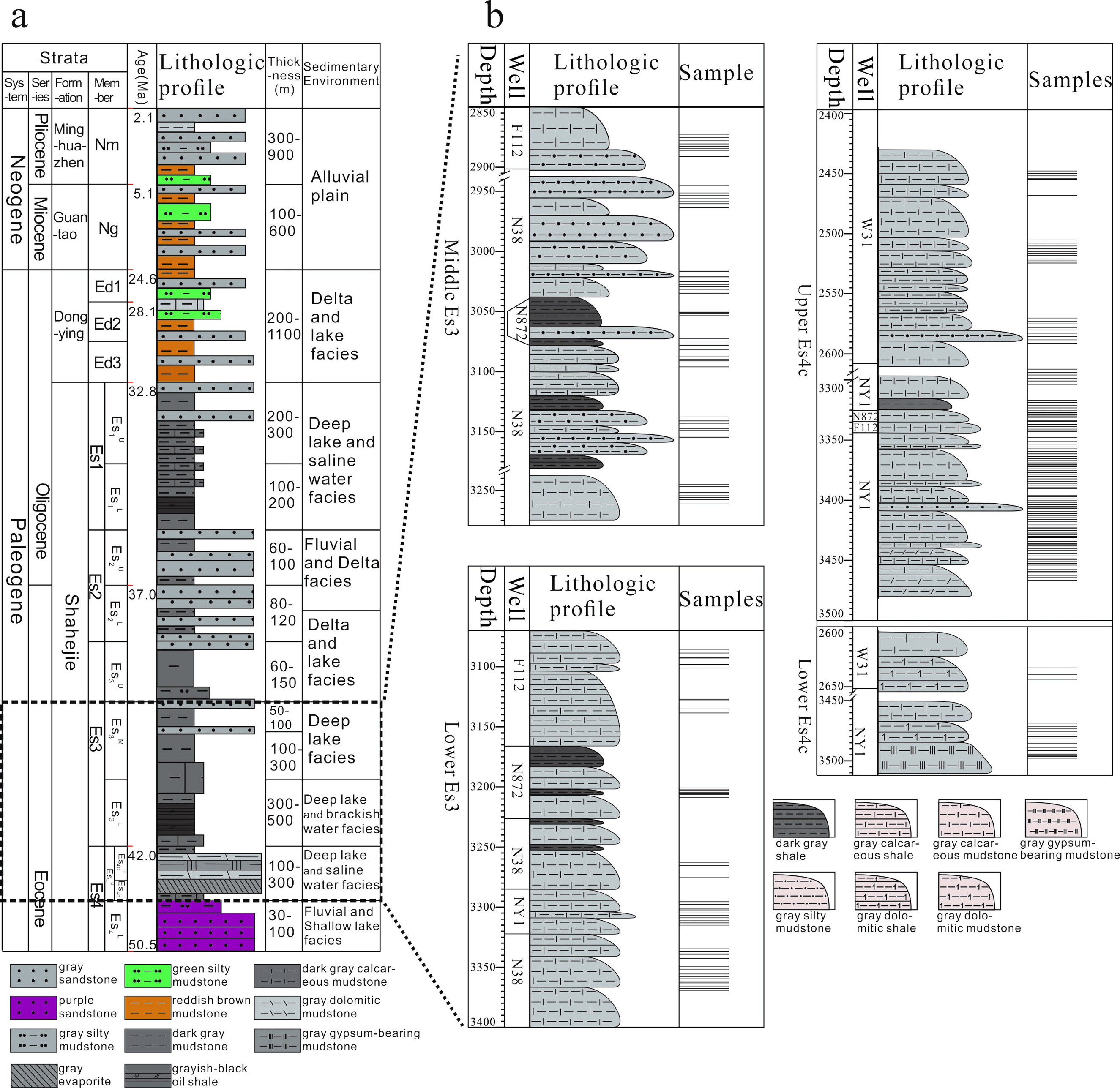
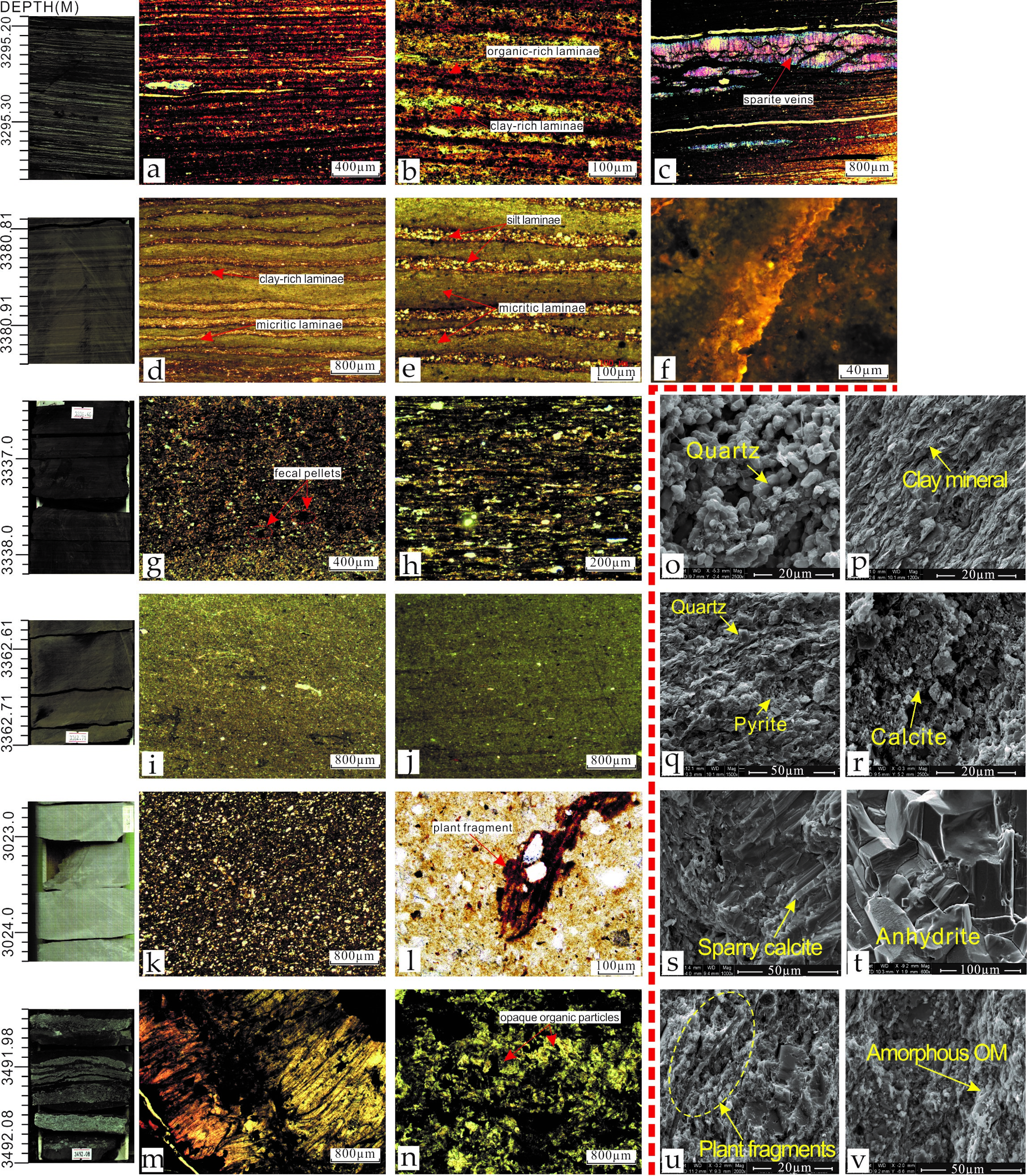
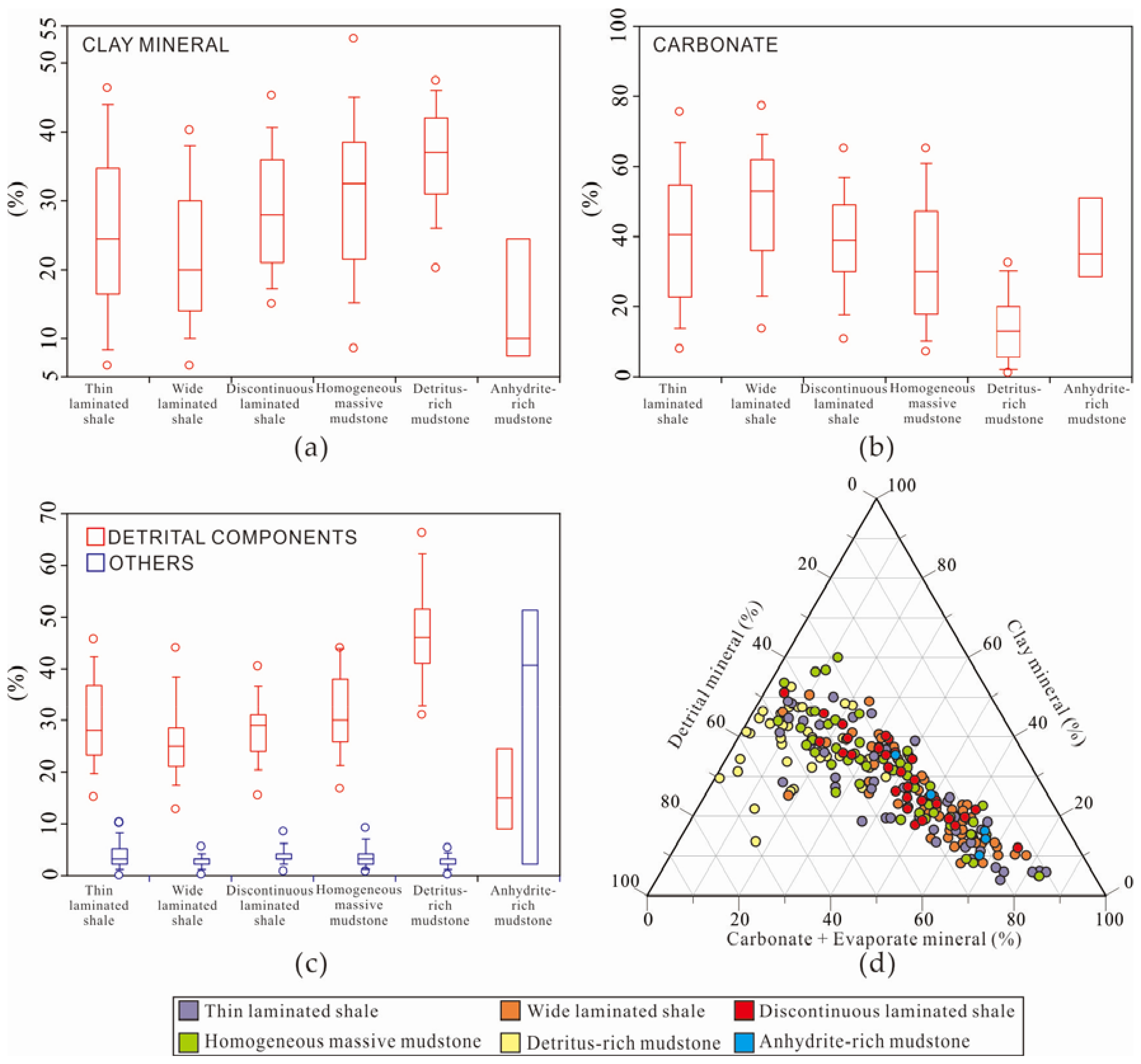
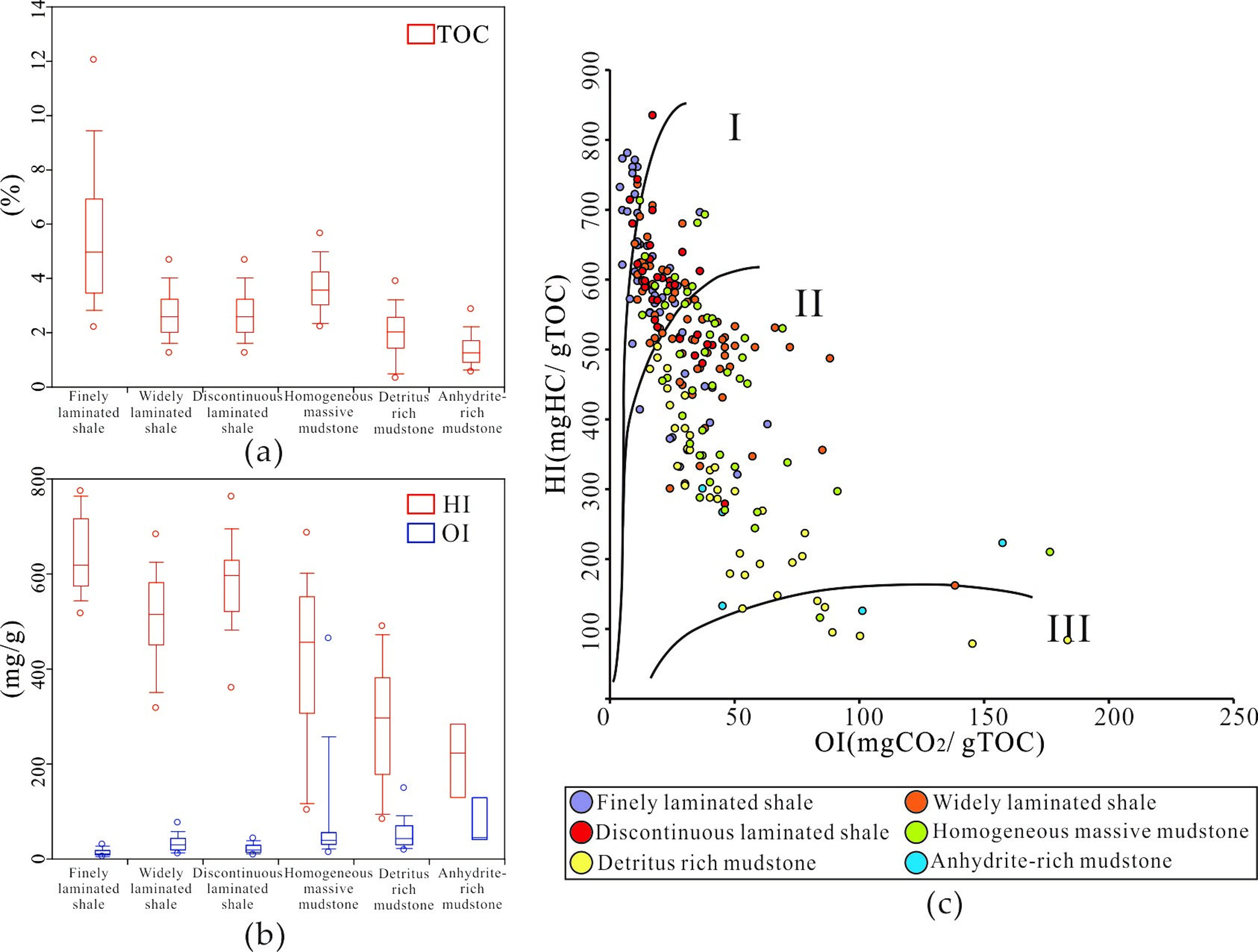
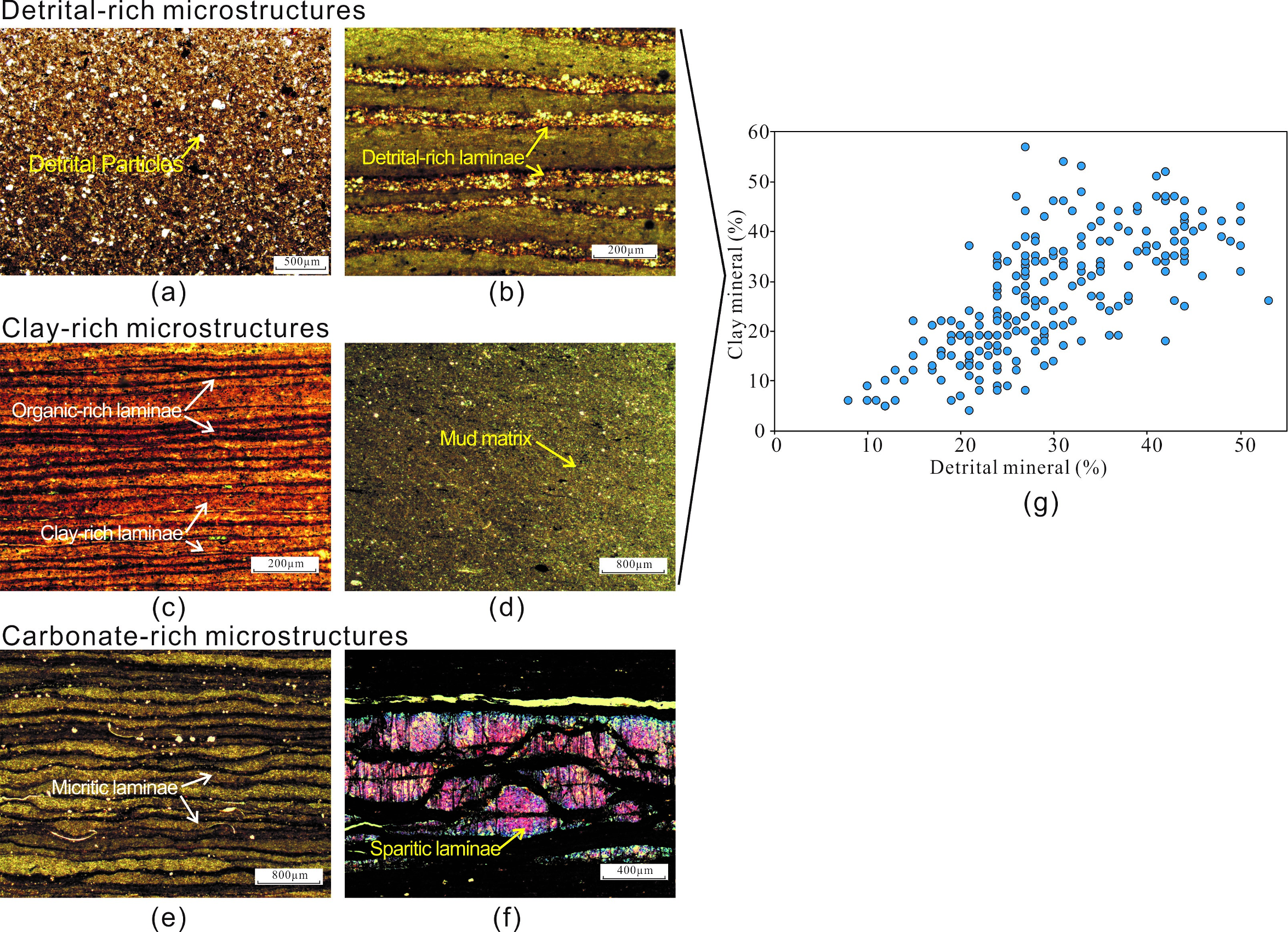
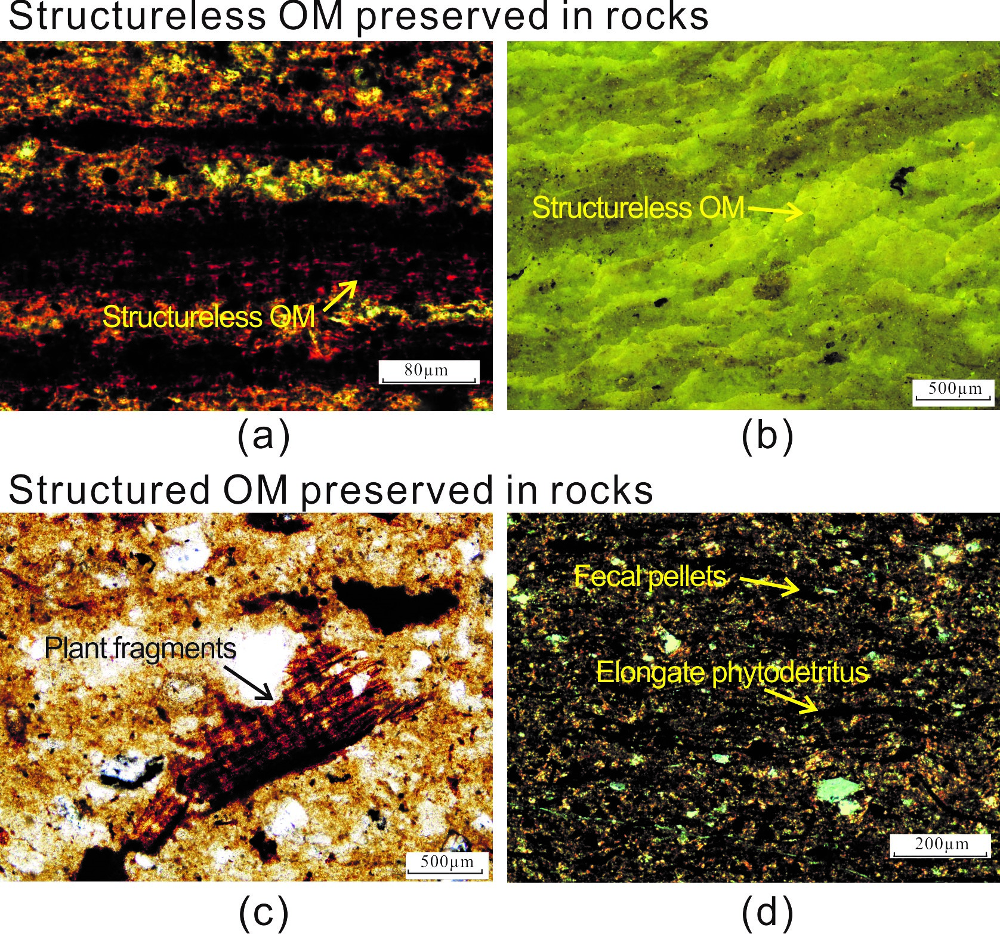
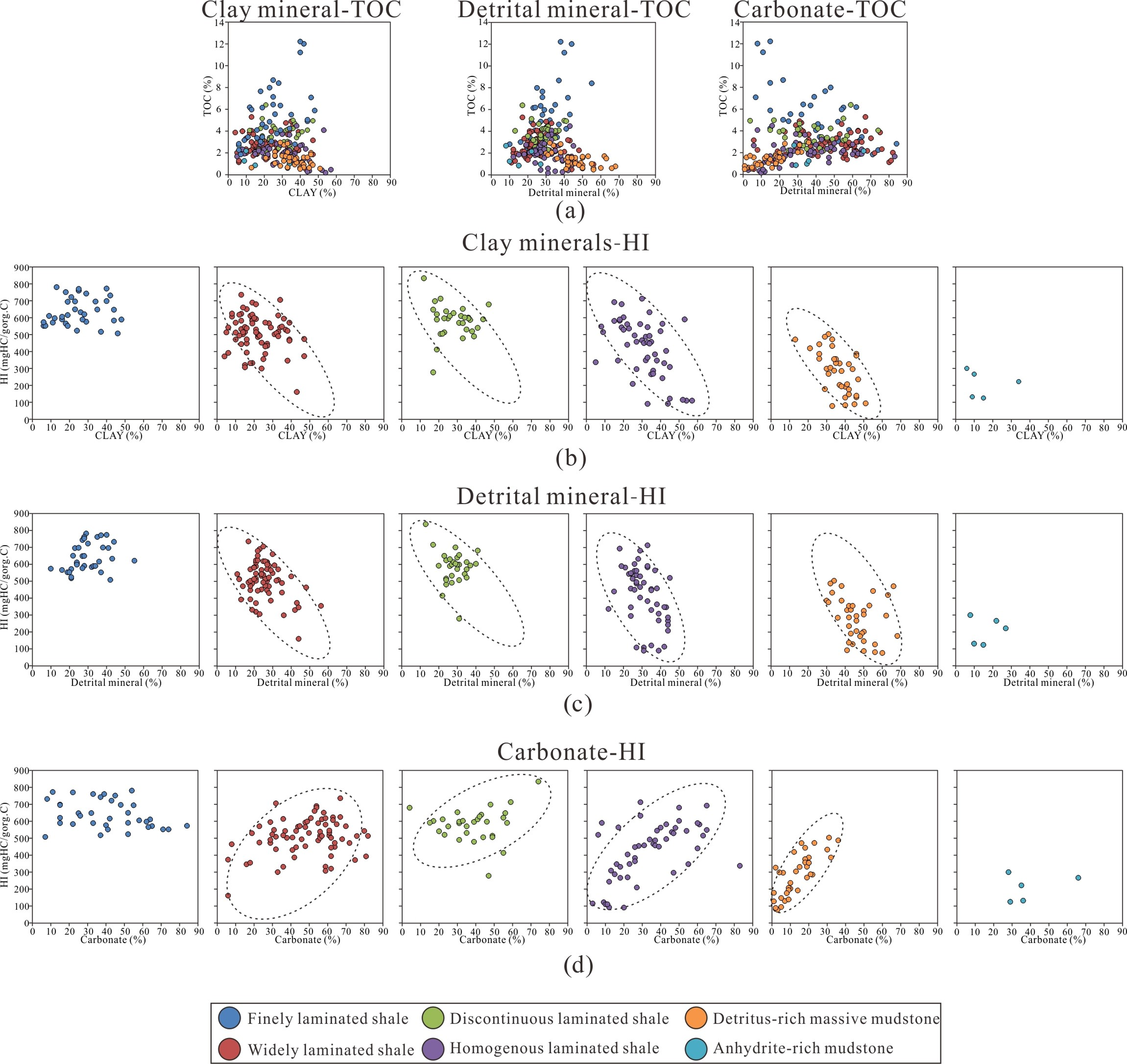
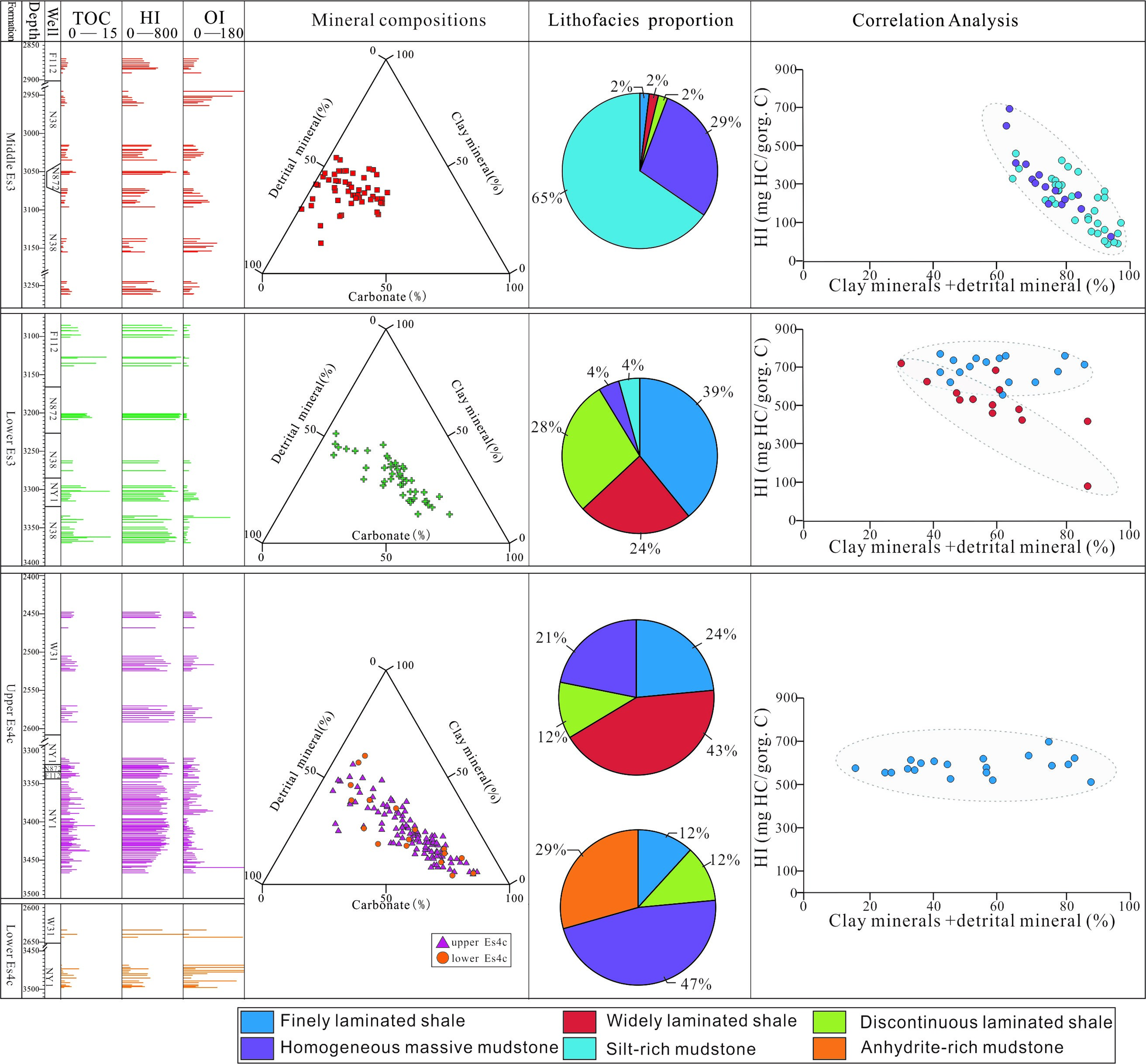
| Number of Samples | Mineral Composition Content | Pyrolysis Characteristics | ||||||||
|---|---|---|---|---|---|---|---|---|---|---|
| Clay Mineral | Carbonate | Detrital Mineral | Evaporated Mineral | TOC | HI | OI | Tmax (°C) | Kerogen Types | ||
| Finely laminated shale | 36 | Mainly type I | ||||||||
| Widely laminated shale | 73 | Mainly type II | ||||||||
| Discontinuous laminated shale | 31 | Mainly type I | ||||||||
| Homogeneous massive mudstone | 50 | Mainly type II | ||||||||
| Silt-rich mudstone | 37 | Type II-III | ||||||||
| Anhydrite-rich mudstone | 5 | Type II-III | ||||||||
| Lithofacies | Types of Laminae | Mineral Composition | Organic Matter Characteristics | Kerogen Types | Correlation between OM and Minerals | Sedimentary Processes | Petrogenesis | |
|---|---|---|---|---|---|---|---|---|
| Mineral & TOC | Mineral & HI | |||||||
| Finely laminated shale | light clay-rich laminae | enrichment of clay minerals, a few detrital minerals | organic-rich laminae formed in algal blooms | mainly type I kerogen | positive correlation | positive correlation | physical-chemical deposition | alternation of plankton blooms and clay mineral deposition in quiet water |
| dark organic-rich laminae | enrichment of clay minerals | chemical-biological deposition | ||||||
| sparry veins | sparite | negative correlation | no obvious correlations | diagenesis | ||||
| Widely laminated shale | clay-rich laminae | enrichment of clay minerals and minor detrital minerals | tiny plant fragments in silt laminae; microfossils of algae in carbonate micrite laminae | mainly type II kerogen | no obvious correlations | negative correlation | physical-chemical processes | alternation of carbonate deposition and clay deposition in high-salinity water |
| silty laminae | enrichment of silt-size detrital minerals | |||||||
| organic-rich laminae | minor clay minerals | |||||||
| carbonate micrite laminae | carbonate micrite | approximate positive correlation | biological-induced deposition | |||||
| Discontinuous laminated shale | carbonaceous laminae | carbonate micrite | fecal pellets and algal fossils | mainly type I kerogen | clay and detritus: approximate negative correlation | physical and biological deposition | blooms of plankton in shallow water | |
| mud matrix | enrichment of clay minerals | chemical deposition | ||||||
| lenticular micrite carbonate | micrite calcite | approximate positive correlation | biological-induced deposition | |||||
| Homogeneous massive mudstone | marlite matrix | clay minerals and micrite carbonate | tiny red plant fragments | mainly type II kerogen | clay and detritus: negative correlation carbonate: positive correlation | biochemical deposition | carbonate and clay deposition in shallow water with low paleoproductivity | |
| Silt-rich mudstone | floating detrital grains | quartz and feldspar grains | red fragments of woody tissues of higher plants | type II–III kerogen | negative correlation | physical deposition | abundant terrigenous input in shallow water | |
| mud matrix | mainly clay minerals | |||||||
| minor carbonate | micrite calcite | positive correlation | biological-induced deposition | |||||
| Anhydrite-rich mudstone | anhydrite layers | anhydrite | opaque organic particles | type II–III kerogen | no obvious correlations | chemical and physical deposition in evaporitic environment | evaporite concentration environment | |
| mud matrix | mainly clay minerals | |||||||
© 2018 by the authors. Licensee MDPI, Basel, Switzerland. This article is an open access article distributed under the terms and conditions of the Creative Commons Attribution (CC BY) license (http://creativecommons.org/licenses/by/4.0/).
Share and Cite
Zeng, X.; Cai, J.; Dong, Z.; Bian, L.; Li, Y. Relationship between Mineral and Organic Matter in Shales: The Case of Shahejie Formation, Dongying Sag, China. Minerals 2018, 8, 222. https://doi.org/10.3390/min8060222
Zeng X, Cai J, Dong Z, Bian L, Li Y. Relationship between Mineral and Organic Matter in Shales: The Case of Shahejie Formation, Dongying Sag, China. Minerals. 2018; 8(6):222. https://doi.org/10.3390/min8060222
Chicago/Turabian StyleZeng, Xiang, Jingong Cai, Zhe Dong, Lizeng Bian, and Yuanfeng Li. 2018. "Relationship between Mineral and Organic Matter in Shales: The Case of Shahejie Formation, Dongying Sag, China" Minerals 8, no. 6: 222. https://doi.org/10.3390/min8060222




